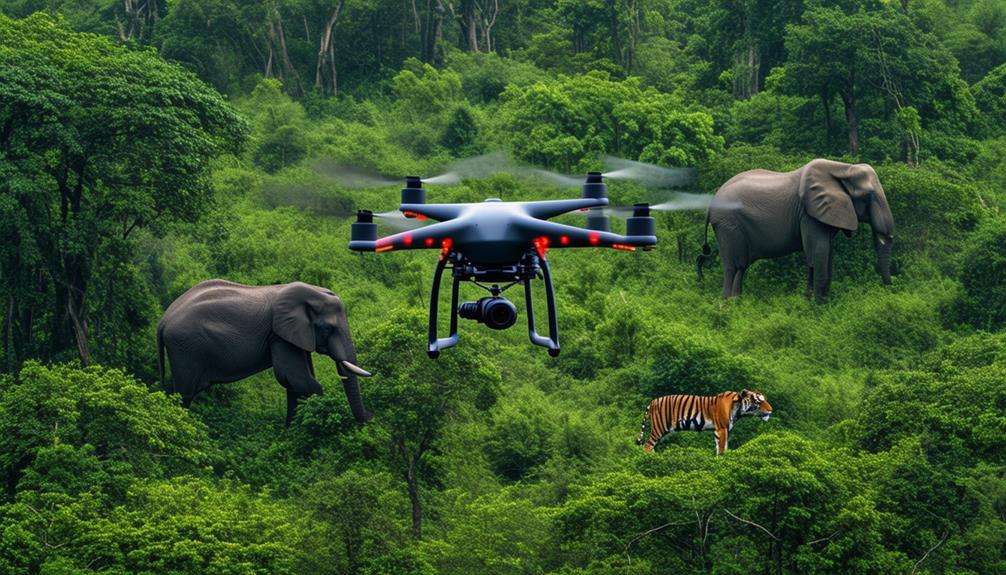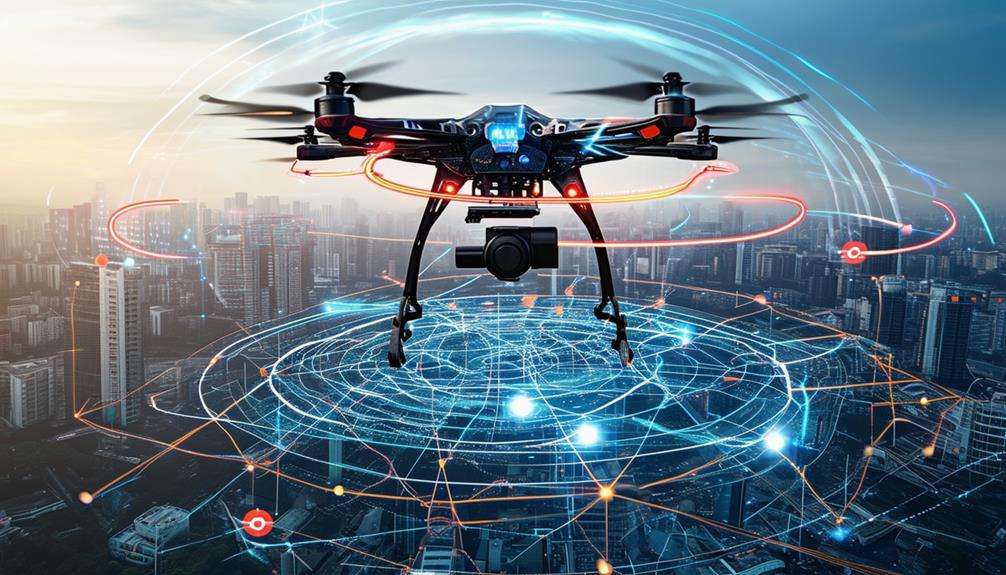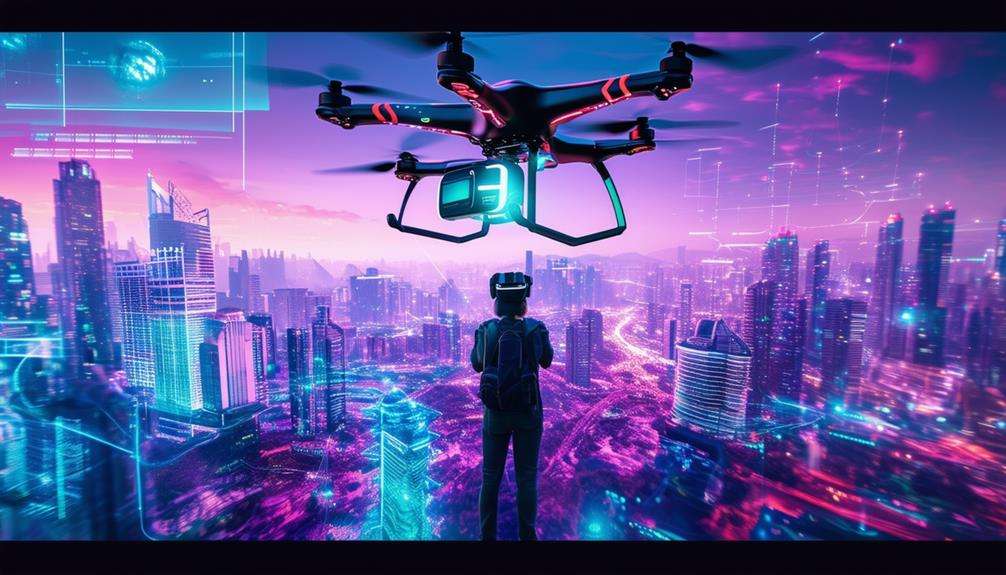The Birth of UAVs: How Drones Were Invented
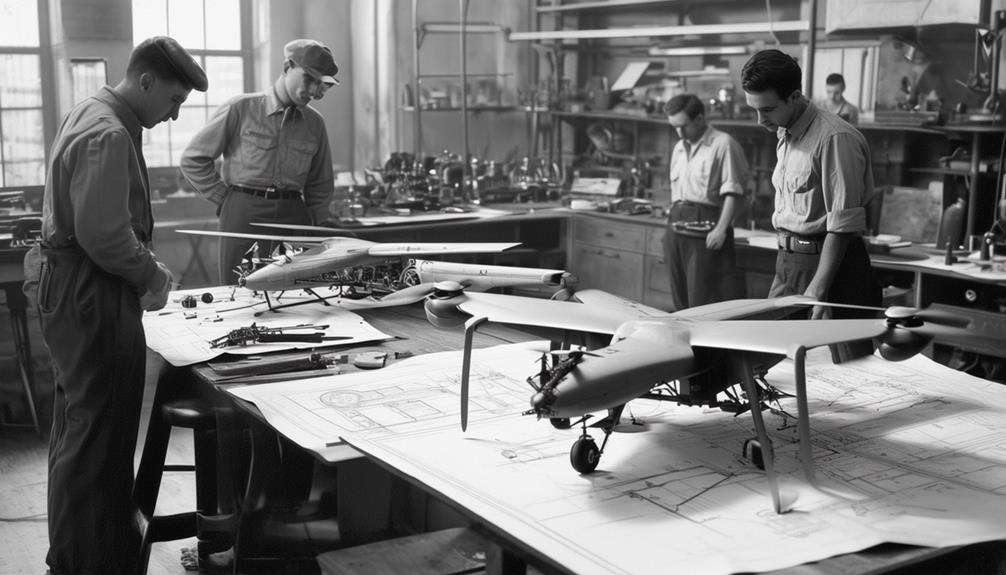
You might be surprised to learn that the concept of UAVs, or drones, isn't as modern as it seems. It actually dates back to the mid-19th century when Austria experimented with incendiary balloons in warfare.
Fast forward to the 1930s, and you'll find significant strides made by Reginald Denny and the US Navy with radio-controlled aircraft. These early innovations set the stage for future advancements in unmanned aircraft.
But how did we go from rudimentary balloons to the sophisticated drones of today? The answer lies in a series of pivotal developments during key historical moments, including advances in radio technology, miniaturization of components, and improvements in navigation systems.
Early Military Experiments
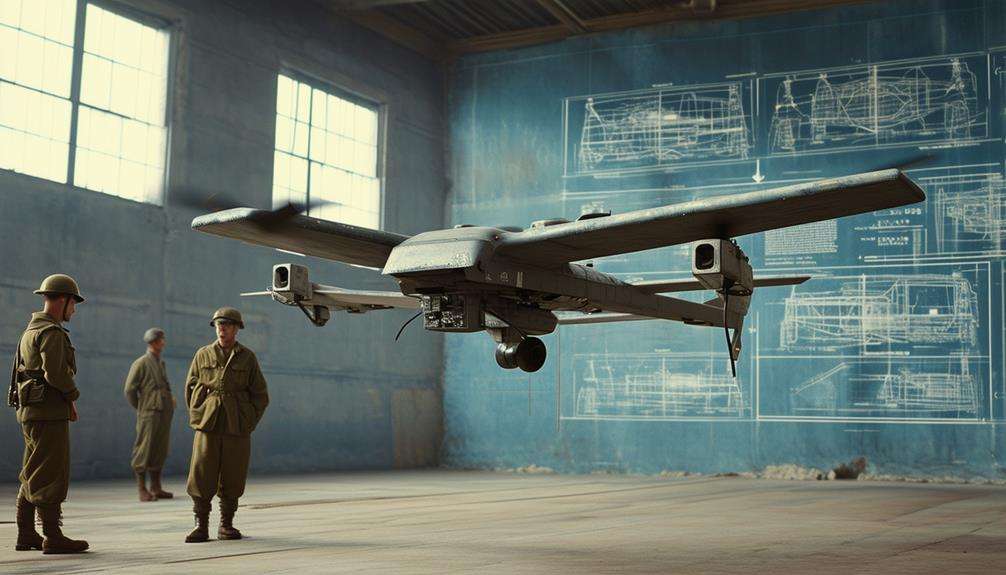
Military experimentation with unmanned aerial vehicles (UAVs) began as early as July 1849 when Austria launched incendiary balloons to attack Venice. This marked the initial offensive use of air power, setting the stage for future developments in drone technology.
By the 1930s, significant advancements had been made in purpose-built drones. Reginald Denny, an actor and aviation enthusiast, played a pivotal role during this period by collaborating with the US Navy on radio-controlled aircraft. In 1937, the US Navy's Curtiss N2C-2 drone showcased early advancements in radio-controlled UAV technology, including the potential for torpedo delivery.
Simultaneously, the Royal Navy was conducting tests on the Larynx cruise missile during the interwar period. This missile was an early example of offensive UAV technology and contributed to the evolving understanding of aerial warfare.
A notable milestone was the introduction of television guidance by Hungarian scientist Dénes Mihály, which provided real-time visual feedback, enhancing the accuracy of drones. These early military experiments laid the groundwork for the sophisticated UAVs we see today, combining offensive capabilities with advanced guidance systems.
The First Quadcopters
Early quadcopters faced significant design challenges, particularly in terms of stability and control. However, technological advancements in the early 1900s, such as those demonstrated by Bartolomeo Ristori's flying machine, showed the potential of multi-rotor aircraft. These innovations laid the foundation for the advanced drones we see today.
Early Design Challenges
The initial quadcopters, developed in the early 1900s, faced significant issues with stability and control due to the technology limitations of the era. These pioneering designs highlighted the difficulties in achieving balance and maneuverability, revealing substantial design challenges. Limited understanding of aerodynamics and rudimentary control systems hindered their effectiveness. Despite these setbacks, early quadcopters demonstrated the potential for remotely controlled aircraft, laying the groundwork for future advancements.
The primary challenges in stability and control stemmed from the lack of sophisticated technology. Engineers had to work with basic materials and primitive propulsion systems, making the quadcopters prone to wobbling and crashes. Over time, the introduction of more advanced aerodynamics and improved control mechanisms helped overcome these initial hurdles.
| Challenges | Description | Impact |
|---|---|---|
| Stability | Difficulty in maintaining balance | Frequent crashes and failures |
| Control | Primitive control systems | Poor maneuverability |
| Technology | Limited materials and tech | Ineffective propulsion systems |
| Aerodynamics | Basic understanding | Inefficient flight dynamics |
| Design Complexity | Complex construction | High failure rates |
Despite these design challenges, the original quadcopters showcased the viability of unmanned aircraft and laid the foundation for future technological advancements.
Technological Breakthroughs
Early 20th-century engineers made groundbreaking progress with pioneering quadcopters, demonstrating the feasibility of unmanned aerial vehicles (UAVs). These early quadcopters showcased the potential for multi-rotor aircraft designs, marking a key technological breakthrough in drone evolution. These innovations laid the foundation for the modern UAV designs and functionalities we see today.
The initial quadcopter prototypes were significant milestones in aerial technology. By incorporating four rotors, these early drones offered improved stability and control over single-rotor designs. This multi-rotor approach proved that quadcopters could be reliable and functional unmanned aircraft.
Technological breakthroughs in quadcopters played a pivotal role in the development of UAVs for various applications, including military reconnaissance, scientific research, and recreational use. The evolution from initial quadcopters to today's advanced UAVs has been remarkable.
World War II Innovations
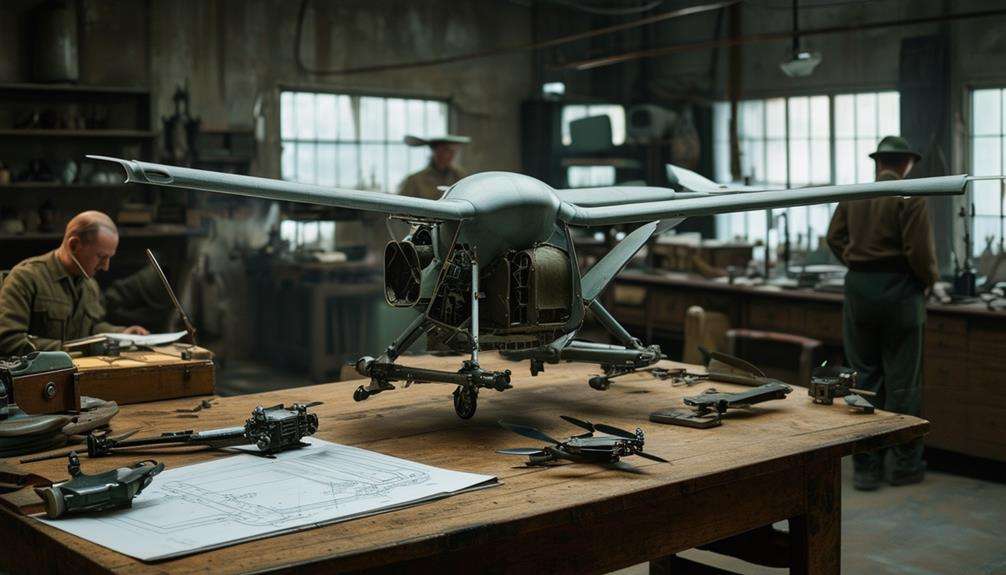
During World War II, drone technology made significant strides, altering military strategy permanently. The emergence of military drones like the Radioplane OQ-2 and the Radioplane OQ-3 played a pivotal role in advancing drone combat capabilities. Reginald Denny, a key figure in this evolution, developed the RP-1 drone and demonstrated it to the US Army in 1935, laying the groundwork for future innovations.
The Curtiss N2C-2, a radio-controlled aircraft, showcased early advancements in drone technology. Edward M. Sorensen's patent for radio-controlled aircraft significantly contributed to these developments. By 1945, the US Navy was using such drones, with notable examples like the OQ-2 being utilized, marking early instances of drone combat.
Three key innovations from World War II include:
- Radioplane OQ-2: Mass-produced for training anti-aircraft gunners.
- RP-1 Drone: Reginald Denny's creation that sparked military interest in drones.
- Curtiss N2C-2: One of the initial radio-controlled aircraft used by the US Navy.
These advancements set the stage for the sophisticated drones we see today, proving that World War II was a critical period for drone technology.
Cold War Developments
During the Cold War, advancements in drone technology significantly transformed military reconnaissance and strategic operations. The introduction of the BTT family of drones showcased their versatility in various military applications. Notably, the RP-71 drone was adapted specifically for aerial photo reconnaissance, providing critical visual intelligence that shaped military decisions.
The period also saw the emergence of drones with specialized functions. Companies like Globe produced target drones essential for training and testing military responses. Northrop's decoy drones, such as the Crossbow and ADM-20 Quail, added sophistication to military strategies by confusing enemy radar and missile systems. These innovations greatly enhanced reconnaissance capabilities, target acquisition, and overall military operations.
The Cold War, marked by geopolitical tension, was also a time of rapid technological progress in unmanned aerial vehicles. Drones became indispensable tools, paving the way for more advanced UAVs in future conflicts. This era marked a significant step in the evolution of drone technology, setting the stage for groundbreaking developments in the years to come.
Vietnam War Advancements
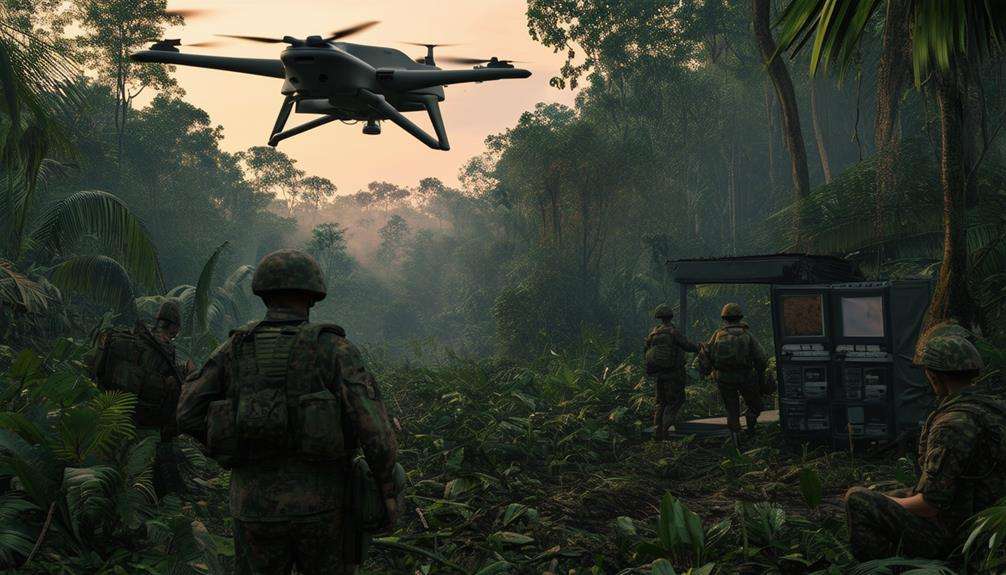
During the Vietnam War, drones were used significantly for reconnaissance missions. The Ryan Model 147 drone was crucial in gathering intelligence and conducting surveillance. Early UAV prototypes proved their effectiveness and versatility, setting the stage for future advancements.
Early UAV Prototypes
The Vietnam War marked a significant evolution in UAV technology with the introduction of advanced models like the Ryan Model 147, which transformed reconnaissance missions for the USAF. These drones played crucial roles in surveillance, decoy operations, and psychological warfare, proving their effectiveness and cost-efficiency. Extensively used over North Vietnam, the Ryan Model 147 demonstrated the potential and reliability of UAVs in military operations.
To understand the journey leading to this advancement, we must look back at earlier prototypes:
- World War I: The Ruston Proctor Aerial Target was developed for the Royal Flying Corps, showcasing the earliest concepts of pilotless aircraft.
- 1930s: The De Havilland Queen Bee, controlled by radio, served as a target drone and was instrumental in training anti-aircraft gunners.
- Post-WWII: Early commercial drones and remotely piloted vehicles (RPVs) began to emerge, laying the foundation for future UAV advancements.
These early prototypes paved the way for the sophisticated UAVs used during the Vietnam War. The success of the Ryan Model 147 and similar drones catalyzed the development of modern UAV programs, revolutionizing military strategy and technology.
Surveillance and Reconnaissance
During the Vietnam War, drones like the Ryan Model 147 transformed military surveillance and reconnaissance operations. These unmanned aerial vehicles (UAVs) were vital for gathering intelligence, providing a comprehensive view of enemy movements and installations. The Ryan Model 147 series was particularly significant due to its capability to operate in dangerous environments where manned aircraft couldn't safely go.
These drones were utilized in multiple roles beyond surveillance and reconnaissance. They served as decoys to mislead enemy radar, took part in missile launches, and contributed to psychological operations aimed at demoralizing enemy forces. The versatility of the Ryan Model 147 made it an invaluable asset during the conflict.
The Vietnam War also underscored the reliability and cost-effectiveness of drones. Unlike manned missions, UAVs could be deployed repeatedly without risking pilot lives, making them an essential option for continuous intelligence gathering.
This period marked a crucial turning point in military strategy, demonstrating how UAVs could enhance operational efficiency and effectiveness. The innovations from this era laid the groundwork for future drone technology, affirming their importance in modern warfare.
Modern Drone Technology
Since the early 2000s, modern drone technology has revolutionized multiple industries through software-controlled flight plans, advanced sensors, and GPS capabilities. Whether for autonomous or remote-controlled tasks, drones have become indispensable tools.
Equipped with high-resolution cameras, commercial drones have transformed photography and videography, making aerial shots accessible to a broader audience. DIY drones have also gained popularity, finding applications in public safety sectors such as police and fire services, though they've raised privacy and safety concerns.
The Federal Aviation Administration (FAA) issued its initial commercial drone permit in 2006, opening the door for various commercial applications. Since then, drone technology has made significant strides, expanding into numerous sectors, including:
- Agriculture: Monitoring crops, tracking livestock, and managing irrigation systems.
- Construction: Conducting site surveys, monitoring progress, and inspecting structures for safety.
- Delivery Services: Companies like Amazon and UPS are testing drones for rapid package delivery.
Technological advancements from 2010 to the present have propelled drones into the mainstream, making them essential for both commercial and recreational use. Adhering to FAA regulations is vital to ensure safe and legal operation as you navigate this evolving landscape.
Conclusion
The evolution of UAVs, from Austrian incendiary balloons to today's advanced drones, is remarkable. Each era, from World War II to the Vietnam War and beyond, has contributed to the sophisticated technology we see today. Understanding this history helps us appreciate the advancements and anticipate future innovations. Remember, past innovations pave the way for tomorrow's breakthroughs. Stay curious and keep exploring!

